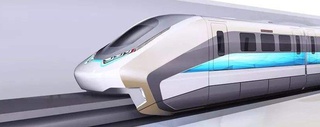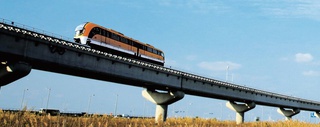Transrapid Design History
Transrapid is a German-made technology designed to transport people on high-speed maglev lines. Siemens AG and ThyssenKrupp Transrapid GmbH were behind this project. Transrapid is a combination of two Latin words: trans as "over" and rapid which means "fast". The development of the first prototypes started in 1969, and the latest iteration, the Transrapid 09, was unveiled in 2007. The 32-kilometer long test track for Transrapid in Lathen was in use since 1980 and in 2011 they have closed it down. After decades of work, the Transrapid is no longer in development.
Transrapid 01 - 1970
The Transrapid 01 was based on the invention by the engineer Hermann Kemper from Nortrup who applied for a patent for the invention of a "suspension railway with wheelless vehicles, which is guided along iron tracks by means of magnetic fields" in 1934. This was the original magnetic suspension railway, the maglev. The development of Transrapid started in 1969 and it was an indoor-only model tested on a 6-meter long track. The boxy shape of this early model was for testing purposes only, the next iterations had more aerodynamic lines.

Transrapid 02 - 1971
The Transrapid 02 was tested on a 930-meter long track with a curve. The train was displayed at the Paris Expo in the summer of 1973. The Transrapid 02 was able to achieve a top speed of 164 km/h (102 mph).

Transrapid 03 - 1972
During the evolution of Transrapid, there was a failed attempt at developing a vehicle with air-cushion propelled by a linear motor. The air-cushion works like on hovercrafts, instead of magnetic levitation air kept the train above ground. This technology proved to be very inefficient as well as too loud.

Transrapid 04 - 1973
It was time to be back on the right track in 1973. The Transrapid 04 used electrodynamic suspension (EDS), which is the same system as used in the SCMaglev that will go into commercial operation in 2027 in Japan. They managed to break their own speed-record with this maglev setting a top speed of 253 km/h (157 mph) in 1977.

Transrapid 05 - 1979
This model was built and used in 1979 for the International Transport Exhibition in Hamburg to showcase the technology on a 903-meter long track. During the time of the exhibition, it carried 55,000 people at a top speed of 75 km/h (46.6 mph).

Transrapid 06 - 1983
The Transrapid 06 was a rocket. It weighed 120 tons and it was 54 meters long. It broke a new Transrapid record in 1988 reaching a speed of 412.6 km/h (256.4 mph). The only faster maglev that time was the Japanese ML-500R model - 517 km/h (321 mph). In 1988 there were plans to build nationwide maglev tracks in Germany, starting with the Hamburg – Hanover route.

Transrapid 07 - 1988
The Transrapid 07 was in development since 1987 with a design speed of 500 km/h (310.7 mph). The trial operation started in 1989 at the magnetic railway test facility in Emsland. In 1993 it reached a speed of 450 km/h (279.6 mph). Experts from the Deutsche Bundesbahn and various universities tested the system's readiness for commercial applications during the spring of 1991.

Transrapid 08 - 1999
Turbulent times were ahead of Transrapid in 1999. It was the rise and the fall of this technological brilliance. The Transrapid 08 was ahead of its time. It was the first high-speed system approved in Europe for automatic operation. It had a design speed of 500 km/h (310.7 mph) with incredible pulling power, taking only 98 seconds to 300 km/h (186.4 mph), and 266 seconds until the top speed of 500 km/h. It was faster, less noisy, more effective than the conventional rail competitor, the ICE. Things were looking bright after signing the contract to build the first Transrapid commercial line in the world in Shanghai in the year of 2000.
A few years later, in 2006 the impossible has happened. Thanks to their unique setup maglevs cannot derail, likewise, two maglevs cannot collide because if two trains are in the same guideway segment, they are forced to go the same direction at the same speed. Unfortunately, human error can end up in tragedy even if the technology is as safe as possible. On 22 September, on the test track in Lathen with 34 people on board, the Transrapid 08 was on its way to showcase the advancement in the maglev rail technology at speeds of up to 450 km/h (279.6 mph). Little did anyone know that they forgot a maintenance vehicle on the track. The emergency breaking slowed down the train, and the crash happened at a speed of 162 km/h (100 mph), killing 22 and injuring 11 people.

Transrapid SMT - 2002
Right before the Lathen accident happened in Germany, and Transrapid proved to be too expensive for most countries to adapt, the Chinese government decided to go ahead and connect the Shanghai Pudong International Airport with Shanghai city. The 30 km long railway was opened to the public on the first day of 2004. The three trains used on this line can reach speeds of up to 431 km/h (268 mph) and the whole trip takes a mere 7 minutes and 20 seconds.

Transrapid 09 - 2007
The last design was the further development of the Transrapid 08, focusing on automation. The design speed was 505 km/h (313.8 mph) with an operating speed of 430 km/h (just like the Transrapid SMT). After the closure of the test facility in Emsland due to the crash of the Transrapid 08, the new version had no future. The only example ever built was sold to the Kemper family (the family of the magnetic levitation rail inventor, Hermann Kemper) for €200,001. The interior of the Transrapid 09 train hosts conference and exhibition rooms.





